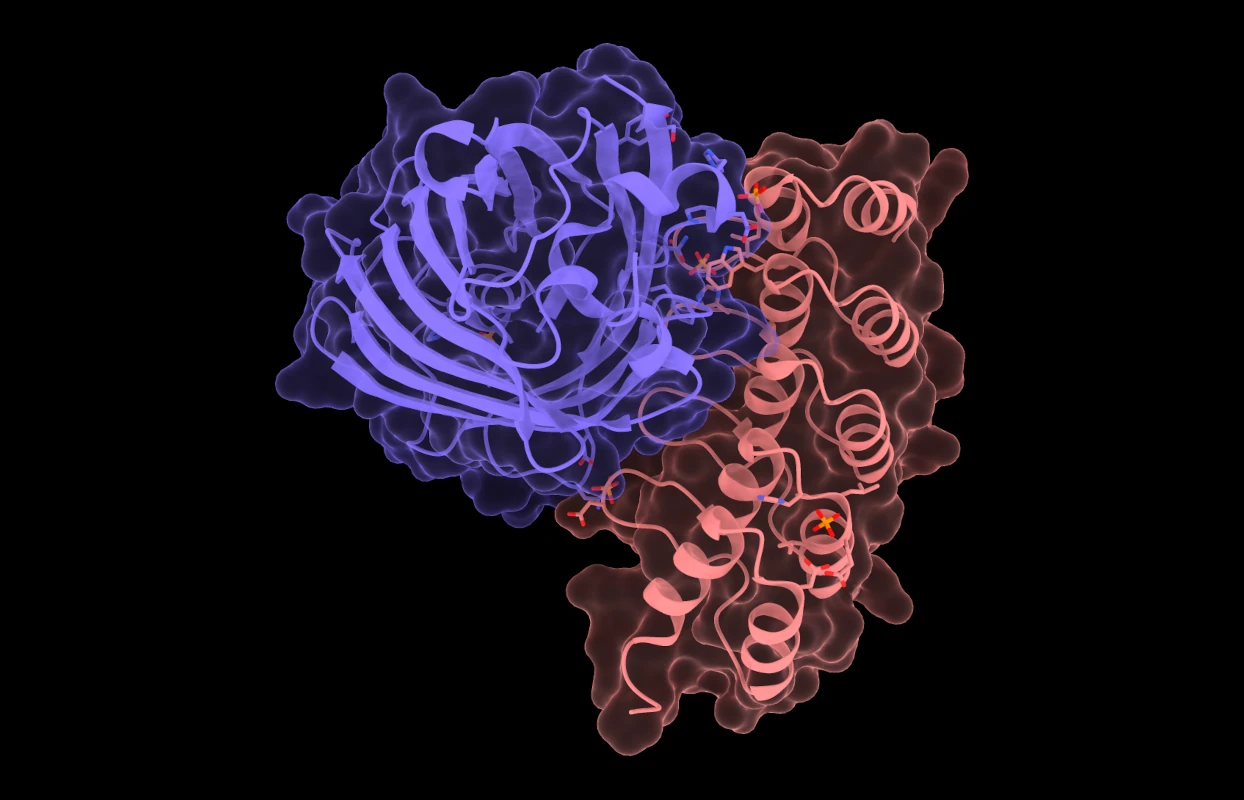What Are DARPins (Designed Ankyrin Repeat Proteins)?
DARPins are engineered non-immunoglobulin protein scaffolds derived from ankyrin-repeat motifs—each ~33 amino acids forming a helix–loop–helix β-hairpin structure (Wikipedia). By assembling 3–5 repeats with protective N- and C-terminal caps, they form stable ~14–18 kDa single-domain proteins with large, concave binding surfaces.
Originally developed in Andreas Plückthun’s lab at the University of Zurich, DARPins are selected from vast libraries (up to 10¹² variants in ribosome display) for high-affinity, specificity, and stability.

Crystal structure of a DARPin (red) bound to a GFP protein (purple) (PDB ID: 5MA6)
Ankyrin Motifs—The Building Blocks
- Length & structure: ~33 residues forming two α-helices with an inter-helical turn (Wikipedia).
- Modularity: Naturally occur in tandem arrays (4–6 repeats common) and mediate protein interactions (Wikipedia).
- Designable: “Consensus” repeat design ensures stability and compatibility—amino acids lining the binding groove can be randomized for target specificity.
Head-to-Head Comparison
| Feature |
DARPins |
Antibodies (IgG) |
Nanobodies (sdAbs) |
scFvs |
Peptides |
| Approx. size |
14–18 kDa |
~150 kDa |
12–15 kDa |
25–30 kDa |
< 5 kDa |
| Structural scaffold |
Modular repeats |
Heavy + light chains, Fc |
Single V-domain |
VH–linker–VL |
Linear peptides |
| Stability |
Extremely high; resist heat, denaturants (Wikipedia, Preprints, MedRxiv, The Plückthun Lab) |
Moderate; sensitive to conditions |
High; heat/chemical tolerant |
Moderate; prone to aggregation |
Low; degrade quickly |
| Expression system |
Bacterial (E. coli) |
Mammalian |
Bacterial |
Bacterial (variable) |
Chemical synthesis |
| Binding affinity & specificity |
Picomolar–nanomolar; comparable to antibodies |
Gold standard (pM to fM) |
High (pM–nM) |
High but aggregation risk |
Variable, generally lower |
| Tissue penetration |
Excellent (small, concave) |
Limited |
Excellent |
Moderate |
Excellent (small size) |
| Engineering versatility |
Very high—modular fusions, multispecific formats |
Moderate; Fc complicates fusions |
Good; stable fusions possible |
Moderate; stability issues |
High; easy modifications |
| Production cost & speed |
Low cost; bacterial fermentation |
High; mammalian culture |
Moderate–low; microbial |
Moderate; bacterial |
Lowest; synthetic |
In‑Depth Insights
✅ Stability & Manufacturability
- DARPins: Full-consensus design yields exceptional stability—resistant to boiling, denaturants, and even months of storage (The Plückthun Lab).
- Antibodies rely on disulfide bonds and glycosylation—making them sensitive and costly to express.
- Nanobodies also offer strong thermal and chemical resilience (Wikipedia), while scFvs can misfold or aggregate easily.
🎯 Binding Affinity & Targeting
- DARPins deliver pM–nM affinity, rivaling antibodies—and their concave binding interface accesses surfaces traditional antibodies cannot (Wikipedia, ScienceNordic).
- Nanobodies, with long CDR3 loops, are adept at binding cryptic epitopes (Wikipedia).
- ScFvs preserve specificity but may lose stability.
- Peptides generally have weaker affinity unless cyclized or scaffolded.
🔄 Modular Design
- DARPins can be fused into multispecific constructs, drug conjugates, or diagnostic agents quickly from a single gene (MedRxiv, SpringerLink).
- Antibody engineering involves complex Fc manipulation.
- Nanobody fusions are emerging, but less modular than DARPins.
- ScFvs are moderately engineerable; peptides offer modification flexibility but less structural control.
Use Cases and Applications
- Therapeutics: DARPins like abicipar pegol (anti‑VEGF) are in Phase III trials, offering longer ocular half-life and reduced injection frequency (SpringerLink, SpringerLink, EurekaSelect).
- Diagnostics & imaging: Deep tumor penetration of mono‑DARPins exceeds antibodies (Journal of Nuclear Medicine).
- Research tools: DARPins serve as crystallization chaperones, intracellular binders, and actin probes (Wikipedia).
- Rapid response: DARPin-based anti‑SARS‑CoV‑2 binders were developed in weeks during COVID‑19 (SpringerLink).
Why Choose DARPins in Protein Design?
- Modular & rational: Repeats can be added/deleted; binding surfaces systematically tailored.
- Robust expression: Bacterial production leads to lower cost and simpler scale-up.
- Exceptional resilience: Withstand extreme conditions—ideal for diagnostics, biosensors, and harsh environments.
- Concave-binding targeting: Access epitopes hidden from antibody loops—ideal for enzyme active sites or protein–protein interfaces.
- Flexible engineering: Easily fused into multispecific or multifunctional proteins.
Conclusion
DARPins combine the best traits of antibodies, nanobodies, scFvs, and peptides—offering compact size (~14 kDa), superior stability, bacterial production, high affinity, and design flexibility. For next-gen protein therapeutics, intracellular targeting, synthetic biology, and diagnostics, DARPins are an increasingly compelling choice—rapidly bridging the gap between natural immunoglobulins and engineered precision.
References & Further Reading
- Wikipedia: DARPin architecture, selection, and properties (ScienceNordic, Wikipedia)
- Plückthun Lab: Full-consensus design and stability data (The Plückthun Lab)
- ScienceNordic: DARPin advantages over antibodies
- Springer – DARPin® drug platform, abicipar & clinical updates (SpringerLink)
- JNM – Tumor penetration superiority
- ACS Nano – Actin‑binding DARPin tools (American Chemical Society Publications)
Also check out our next blog post on designing DARPins against PD‑L1 using NeuroBind.
